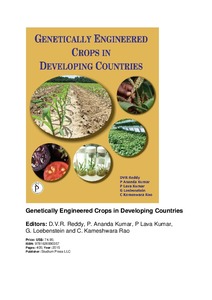| dc.contributor.author | Reddy, D.V.R |
| dc.contributor.author | Kumar, P.A |
| dc.contributor.author | Kumar, P.L. |
| dc.contributor.author | Loebenstein, G. |
| dc.contributor.author | Rao, C.K. |
| dc.date.accessioned | 2019-12-04T11:08:16Z |
| dc.date.available | 2019-12-04T11:08:16Z |
| dc.date.issued | 2015 |
| dc.identifier.citation | Reddy, D.V.R., Kumar, P.A., Kumar, P.L., Loebenstein, G. & Rao, C.K. (Eds.) (2015). Genetically engineered crops in developing countries.U.S.A.: Studium Press LLC |
| dc.identifier.isbn | 1-62699-035-2 |
| dc.identifier.uri | https://hdl.handle.net/20.500.12478/1777 |
| dc.description | 405p.; Cover & table of content attached |
| dc.description.abstract | Alleviation of poverty in developing countries continues to be the main target for scientists as well as administrators. Genetically engineered (GE) crops initially were developed to benefit large scale commercial outfits. They are currently grown on 175 million ha and more than 50% of this is contributed by developing countries. Private sector continues to be the major player in bringing out the GE products with pest resistance, high yield and improved quality. It was shown in the paper that the commercialized GE crops go beyond just the four crops (soybean, maize, cotton and canola) and pest resistance and that several small private players as well as the pubic sector are taking bigger role in technology development. The impact generated by engineered insect and herbicide resistant crops on the agronomic, environmental and socio economic aspects was given, citing appropriate
examples, in various developing countries. In addition to the substantial yield gains, growing them also helped to protect the environment through reduced pesticide application. Public sector is also catching up in generating the technologies that are more suitable for adoption by marginal farmers. Controversies underlying the cultivation ofGE crops especially Bt cotton in India were discussed. The potential the technology offers for poverty alleviation was highlighted. After critically examining the policy frameworks in several developing countries, the paper highlights the desirable changes in the domestic regulatory frameworks and international laws for effective harnessing of the technology for optimum social welfare. |
| dc.format.extent | 405 |
| dc.language.iso | en |
| dc.subject | Food Security |
| dc.subject | Food Prices |
| dc.subject | Social Welfare |
| dc.subject | Genetically Engineered Crops |
| dc.subject | Developing Countries |
| dc.title | Genetically engineered crops in developing countries |
| dc.type | Book |
| dc.description.version | Peer Review |
| cg.contributor.crp | Roots, Tubers and Bananas |
| cg.contributor.crp | Grain Legumes |
| cg.contributor.affiliation | Acharya NG Ranga Agricultural University |
| cg.contributor.affiliation | International Institute of Tropical Agriculture |
| cg.contributor.affiliation | Tel Aviv University |
| cg.contributor.affiliation | Foundation for Biotechnology Awareness and Education, Bangalore |
| cg.coverage.region | Asia |
| cg.coverage.region | South Asia |
| cg.coverage.country | India |
| cg.authorship.types | CGIAR and developing country institute |
| cg.iitasubject | Genetic Improvement |
| cg.iitasubject | Socioeconomy |
| cg.howpublished | Formally Published |
| cg.accessibilitystatus | Limited Access |
| local.dspaceid | 83229 |

